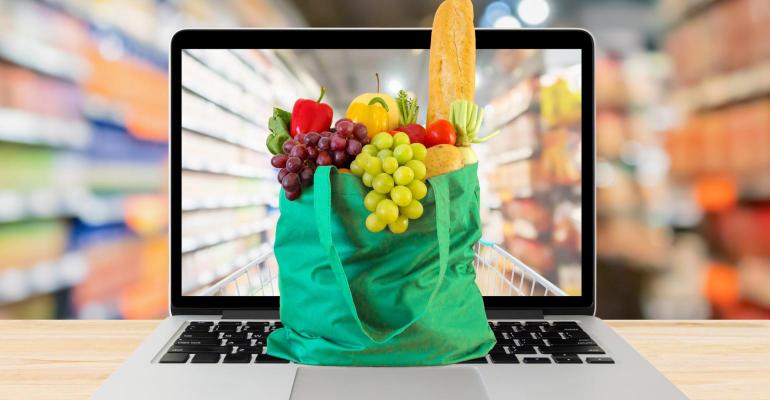Without question, online grocery purchases have soared since the COVID-19 outbreak, reflecting shifts in consumer behavior since the virus spread across the US. What's more, many of these shoppers are first-time online grocery customers. The big question is, will these shoppers and these new consumer behaviors remain as the crisis continues?
During an SN webinar in June, we posed that question and more to two of the food retail industry’s top thought leaders, Willard “Bill” Bishop, co-founder and chief architect of Brick Meets Click, and Jim Hertel, senior vice president of analytics at Inmar Intelligence. As Hertel put it, “COVID-19, in its own way, has been an unprecedented, if unplanned trial opportunity for online grocery.”
The numbers certainly bear that out.
As Inmar reported last month, nearly 80% of consumers polled reported shopping online for groceries after the COVID-19 outbreak, twice the number as before the pandemic. Meanwhile, Brick Meets Click in its monthly online grocery scorecard noted that online grocery purchases continued to grow in May, with demand spurred by the COVID-19 crisis lifting sales 24% month-over-month to $6.6 billion. Total online grocery orders in May rose 18% to 73.5 million from 62.5 million in April.
For first-time users, there is an added element of safety in online grocery. In addition to convenience, Hertel told us that online grocery offers “a promise of safety and a touch-free experience where certain consumers feel like they do not want to go into a brick-and-mortar outlet of any variety — and certainly with the frequency of grocery shopping — they don't want to subject themselves to do that on an ongoing basis. Online grocery is a perfect answer for that. I think that feeling of safety is turning out to be a new foundational element of the shopper value equation. And I do believe that that's a durable value proposition.”
And any fears of a negative backlash against online grocery due to early COVID-19 hiccups such as out-of-stocks and long fulfillment times may be overblown, said Bishop. “I do think that a number of people have been put off by the out of stocks, not being able to get a slot to shop, things like that,” he told us. “But overall, I think we're going to find people very interested in delivery and retailers becoming quite a bit more competent in the delivery process and doing it more efficiently so that the business will be that much more profitable. So I don't think we've got any permanent damage in that regard.”
Here are excerpts from the webinar conversation, moderated by SN senior editor Russell Redman:
SN: One of the notable developments we've been seeing are a lot of new consumers entering the online grocery arena. And obviously this represents big opportunities for players in this space. Jim, what are your thoughts on whether these first-time users will remain online grocery shoppers?

Jim Hertel: I think a substantial portion of them will remain online grocery shoppers. But there are two really important aspects that will impact that behavior. The first is the customer experience. Anytime you have trial is trying something new — and in this case it wasn't necessarily by choice — the customer experience, how easy, how convenient, what we would characterize as in-home fill rate, if I ordered 10 things, did I get all 10 exactly as I had ordered? Etc, etc. That's going to be really, really important. Make it easy for them to shop and make that convenient, in the sense that we're going to deliver everything that you asked for. I think quite frankly, looking back, both in the data as well as anecdotally, based on our own experiences, I give the industry probably a C or C-plus overall from that standpoint.
The second thing I would point out is, I think in many ways, for these first-time users, the bar has been raised beyond simply filling out a shopping list, clicking pickup or deliver and paying for it. What we're seeing in the data is that a significant number of those shoppers really want to understand in-stock position. Is that product in the store? Is it available to me online? And if it's not available now, either in store or online, please let me know when I can order and receive. That is a step up in terms of consumer requirements and consumer demands. It's probably a function of the environment we're in right now. But you can just start to see consumer expectations climbing.
SN: Will this surge during the pandemic be the thing that finally boosts online grocery acceptance and makes it a major business for retailers?

Bill Bishop: Well, that is the $64 question. Where is this going to lead? Let me give you three steps that I think we're going to see in front of us over the next 24 months. Number one, I think you're going to see pickup accelerate. And that will be in large measure, because quite frankly, that's the option that will be pushed toward the customer and it will get better as an experience. So expect more movement in the direction of pickup in the short term.
Soon following after that, and with the application of new technology, I think you're going to see a number of retailers with the proposition that their delivery is actually better than a trip to the store. Retailers will figure out how to do delivery even better, and the average customer is going to find that's a good way to use their time.
The third step will be and I think within the next 12 months we'll see the first of these, where we change the physical store, so that the only way you can order and get packaged products, refrigerated as well as ambient, is by ordering online in advance or at a kiosk and that there is no self-service option. It’s all coming out of a storage and retrieval system and basically 80% of the product is processed at a very, very low cost with the automation. So that sounds very futuristic, but people have tried it, and you can see the plans on the drawing room tables right now. So I'm pretty sure within 24 months, one or more of those stores will be up and running.
For more of our conversation with Bill Bishop and Jim Hertel on topics including curbside vs. pickup, service fees for delivery or pickup, online basket size, consumer demographics and more, be sure to check out the complete webinar on demand here.
For our most up-to-date coverage, visit the coronavirus homepage.





